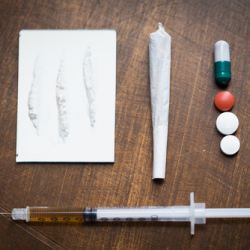The Diagnostic and Statistical Manual of Mental Disorders (DSM) V has relegated the terms substance abuse and substance dependence, replacing them with substance use. Substance use disorders (SUD) are characterized as mild, moderate, or severe according to the new diagnostic criteria which require evidence of impaired control, social impairment, risky use and pharmacological indicators (tolerance and withdrawal). The actual substances in consideration include alcohol, cannabis, hallucinogens, inhalants, opioids, sedatives/ hypnotics/ anxiolytics, stimulants, and tobacco.
The 2014 National Survey on Drug Use and Health cited that approximately 21.5 million people aged 12 or older had a substance use disorder (SUD) in 2014, including 17.0 million with an alcohol use disorder, 7.1 million with an illicit drug use disorder, and 2.6 million who had both an alcohol use and an illicit drug use disorder. The statistics suggest that substance use may be a missed diagnosis in cases across the country, and possibly point to the need for more comprehensive, routine, and effective screening of patients, young and older when they present for medical care.
In a journal article published in the Annals of Internal Medicine, McNeely et al. assess and compare the performance of a new screening tool for substance use to the current gold standard, the modified Composite International Diagnostic Interview (CIDI). The study assessed the Tobacco, Alcohol, Prescription medication, and other Substance use (TAPS) tool in a primary care population across five adult primary care clinics within urban and suburban regions. The TAPS tool is a two-part screening questionnaire, designed to assess further and score substance use habits based on initial positive or negative answers to five specific questions regarding substance use habits within the past twelve months.
A total of 2000 adult patients were recruited for the study. Two versions of the TAPS tool were administered to each patient: interviewer-administered and self-administered with the use of a tablet. After this, the interviewer then administered questionnaires regarding the feasibility and acceptability of the TAPS tool, after which the CIDI was completed for comparative purposes. Oral fluid testing for drugs was also done once the patient gave verbal consent.
With regards to how practical the TAPS tool is in a primary care setting, 99 percent of the participants stated they were comfortable answering the questions, and 95 percent would be willing to share the results with their physician. Additionally, the ability to have a self-administered version of the tool may also facilitate its use as it alleviates some of the anxiety patients experience over the stigma and judgment associated with substance use.
The likely barrier to implementation of the TAPS tool may be determining the optimal cutoff score for substance use. For substances with a high prevalence (tobacco, alcohol, and marijuana), the sensitivity and specificity for identifying problem use (with a cutoff score of 1+) were good.(1) However, for detecting substance use (with a cutoff score of 2+), sensitivity, in particular, was comparably lower.(2)
By the structure and content of the questions asked, a physician can identify specific substances that pose a problem to the patient's health and well-being and so interventions/treatments can be tailored. For this reason, the TAPS tool shows promise for integration into the primary health care service as a screening method. However, as researchers noted, the precision of the TAPS tool in identifying substance use is dependent on the optimal cutoff score, as well as the prevalence of the drug classes. Therefore, before the TAPS tool can be integrated into primary care, these limitations must be addressed.
NOTES
(1) For identifying problem use, the TAPS tool had a sensitivity and specificity of 0.93 and 0.87 for tobacco, 0.74 and 0.79 for alcohol, and 0.82 and 0.93 for marijuana, respectively.
(2) For identifying substance use, the TAPS tool had a sensitivity and specificity of 0.74 and 0.89 for tobacco, 0.70 and 0.85 for alcohol, and 0.71 and 0.95 for marijuana, respectively.

